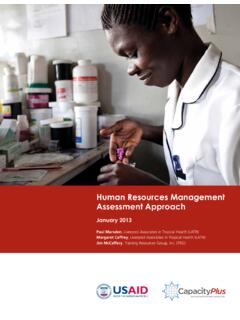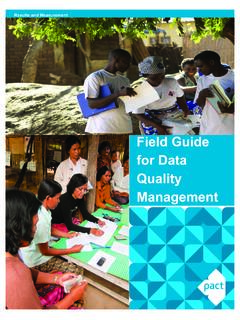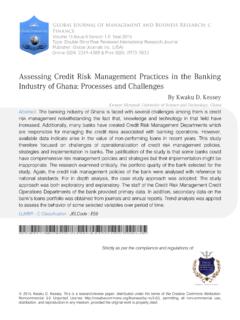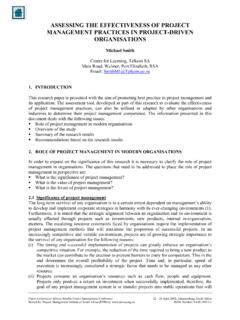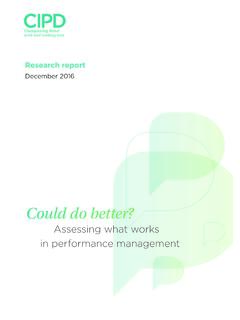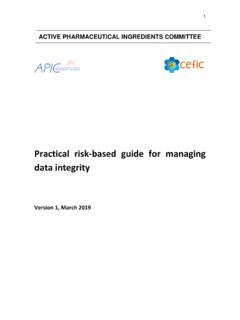Transcription of Key Practices in Cyber Supply Chain Risk Management ...
1 NISTIR 8276. Key Practices in Cyber Supply Chain Risk Management : Observations from Industry Jon Boyens Celia Paulsen Nadya Bartol Kris Winkler James Gimbi This publication is available free of charge from: NISTIR 8276. Key Practices in Cyber Supply Chain Risk Management : Observations from Industry Jon Boyens Celia Paulsen Computer Security Division Information Technology Laboratory Nadya Bartol Kris Winkler James Gimbi Boston Consulting Group New York, NY. This publication is available free of charge from: February 2021. Department of Commerce Wynn Coggins, Acting Secretary National Institute of Standards and Technology James K. Olthoff, Performing the Non-Exclusive Functions and Duties of the Under Secretary of Commerce for Standards and Technology & Director, National Institute of Standards and Technology National Institute of Standards and Technology Interagency or Internal Report 8276. 31 pages (February 2021). This publication is available free of charge from: Certain commercial entities, equipment, or materials may be identified in this document in order to describe an experimental procedure or concept adequately.
2 Such identification is not intended to imply recommendation or endorsement by NIST, nor is it intended to imply that the entities, materials, or equipment are necessarily the best available for the purpose. There may be references in this publication to other publications currently under development by NIST in accordance with its assigned statutory responsibilities. The information in this publication, including concepts and methodologies, may be used by federal agencies even before the completion of such companion publications. Thus, until each publication is completed, current requirements, guidelines, and procedures, where they exist, remain operative. For planning and transition purposes, federal agencies may wish to closely follow the development of these new publications by NIST. Organizations are encouraged to review all draft publications during public comment periods and provide feedback to NIST. Many NIST cybersecurity publications, other than the ones noted above, are available at Comments on this publication may be submitted to: National Institute of Standards and Technology Attn: Computer Security Division, Information Technology Laboratory 100 Bureau Drive (Mail Stop 8930) Gaithersburg, MD 20899-8930.
3 Email: All comments are subject to release under the Freedom of Information Act (FOIA). NISTIR 8276 KEY Practices IN Cyber SCRM: OBSERVATIONS FROM INDUSTRY. Reports on Computer Systems Technology The Information Technology Laboratory (ITL) at the National Institute of Standards and Technology (NIST) promotes the economy and public welfare by providing technical leadership for the Nation's measurement and standards infrastructure. ITL develops tests, test methods, reference data , proof of concept implementations, and technical analyses to advance the development and productive use of information technology. ITL's responsibilities include the development of Management , administrative, technical, and physical standards and guidelines for the cost-effective security and privacy of other than national security-related information in federal information systems. Abstract This publication is available free of charge from: In today's highly connected, interdependent world, all organizations rely on others for critical products and services.
4 However, the reality of globalization, while providing many benefits, has resulted in a world where organizations no longer fully control and often do not have full visibility into the Supply ecosystems of the products that they make or the services that they deliver. With more and more businesses becoming digital, producing digital products and services, and moving their workloads to the cloud, the impact of a cybersecurity event today is greater than ever before and could include personal data loss, significant financial losses, compromise of product integrity or safety, and even loss of life. Organizations can no longer protect themselves by simply securing their own infrastructures since their electronic perimeter is no longer meaningful; threat actors intentionally target the suppliers of more Cyber -mature organizations to take advantage of the weakest link. That is why identifying, assessing , and mitigating Cyber Supply Chain risks is a critical capability to ensure business resilience.
5 The multidisciplinary approach to managing these types of risks is called Cyber Supply Chain Risk Management (C-SCRM). This document provides the ever- increasing community of digital businesses a set of Key Practices that any organization can use to manage cybersecurity risks associated with their Supply chains. The Key Practices presented in this document can be used to implement a robust C-SCRM function at an organization of any size, scope, and complexity. These Practices combine the information contained in existing C- SCRM government and industry resources with the information gathered during the 2015 and 2019 NIST research initiatives. Keywords best Practices ; Cyber Supply Chain risk Management ; C-SCRM; external dependency Management ; information and communication technology Supply Chain risk Management ; ICT. SCRM; key Practices ; risk Management ; supplier; Supply Chain ; Supply Chain assurance; Supply Chain risk; Supply Chain risk assessment; Supply Chain risk Management ; Supply Chain security.
6 Third-party risk Management . ii NISTIR 8276 KEY Practices IN Cyber SCRM: OBSERVATIONS FROM INDUSTRY. Supplemental Content For information about NIST's Cyber Supply Chain Risk Management Program, visit Acknowledgments The authors Jon Boyens of the National Institute of Standards and Technology (NIST), Celia Paulsen (NIST), Nadya Bartol of the Boston Consulting Group (BCG), Kris Winkler (BCG), and James Gimbi (BCG) would like to acknowledge and thank a number of organizations who provided valuable input into this publication: Mayo Clinic; Palo Alto Networks, Inc.; Seagate Technology PLC; Boeing; Exostar; Cisco Systems; Deere DuPont de Nemours Inc.; Exelon Corporation; FireEye; Fujitsu Ltd.; Great River Energy; Intel Corporation; Juniper This publication is available free of charge from: Networks, Inc.; NetApp, Inc.; Northrop Grumman Corporation; Resilinc Corporation;. Schweitzer Engineering Laboratories, Inc.; Smart Manufacturing Leadership Coalition; and The Procter & Gamble Company.
7 Audience All organizations rely on acquiring products and services, and most organizations also Supply products and services to other organizations. Cyber Supply Chain Risk Management is an organization-wide function that encompasses multiple activities throughout the system development life cycle. The audience for this publication is any organization regardless of its size, scope, or complexity that wants to manage the cybersecurity risks stemming from extended Supply chains and Supply ecosystems. Patent Disclosure Notice NOTICE: ITL has requested that holders of patent claims whose use may be required for compliance with the guidance or requirements of this publication disclose such patent claims to ITL. However, holders of patents are not obligated to respond to ITL calls for patents and ITL has not undertaken a patent search in order to identify which, if any, patents may apply to this publication. As of the date of publication and following call(s) for the identification of patent claims whose use may be required for compliance with the guidance or requirements of this publication, no such patent claims have been identified to ITL.
8 No representation is made or implied by ITL that licenses are not required to avoid patent infringement in the use of this publication. iii NISTIR 8276 KEY Practices IN Cyber SCRM: OBSERVATIONS FROM INDUSTRY. Executive Summary The National Institute of Standards and Technology (NIST) Cyber Supply Chain risk Management (C-SCRM) program was initiated in 2008 to develop C-SCRM Practices for non-national security systems in response to Comprehensive National Cybersecurity Initiative (CNCI) #11: Develop a multi-pronged approach for global Supply Chain risk Management . Over the last decade, NIST has continued to develop publications and conduct further research on industry best Practices for C-SCRM. This document presents Key Practices and recommendations that were developed as a result of the research conducted in 2015 and 2019, including expert interviews, development of case studies, and analysis of existing government and industry resources. This publication is available free of charge from: The Key Practices presented in this document can be used to implement a robust C-SCRM.
9 Program or function at an organization of any size, scope, or complexity. These Practices combine the information contained in existing C-SCRM government and industry resources with the information gathered during the 2015 and 2019 NIST research initiatives. The Key Practices are: 1. Integrate C-SCRM Across the Organization 2. Establish a Formal C-SCRM Program 3. Know and Manage Critical Suppliers 4. Understand the Organization's Supply Chain 5. Closely Collaborate with Key Suppliers 6. Include Key Suppliers in Resilience and Improvement Activities 7. Assess and Monitor Throughout the Supplier Relationship 8. Plan for the Full Life Cycle Each Key Practice includes a number of recommendations that synthesize how these Practices can be implemented from a people, process, and technology perspective. Selected key recommendations include: - Create explicit collaborative roles, structures, and processes for Supply Chain , cybersecurity, product security, physical security, and other relevant functions.
10 - Integrate cybersecurity considerations into the system and product life cycle. - Determine supplier criticality by using industry standards and best Practices . - Mentor and coach suppliers to improve their cybersecurity Practices . - Include key suppliers in contingency planning (CP), incident response (IR), and disaster recovery (DR) planning and testing. - Use third-party assessments, site visits, and formal certification to assess critical suppliers. These and several other recommendations are mapped to each of the Key Practices to assist in and support the implementation of effective C-SCRM Practices within an organization. Additional C-SCRM resources, including industry-specific best Practices , can be found in Appendix B, Government and Industry Resources. iv NISTIR 8276 KEY Practices IN Cyber SCRM: OBSERVATIONS FROM INDUSTRY. Table of Contents Executive Summary .. iv 1 Introduction .. 1. Purpose and Scope .. 3. Background .. 3. 2 Problem Definition.










